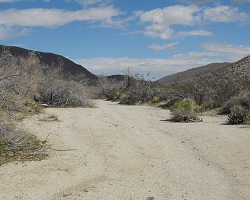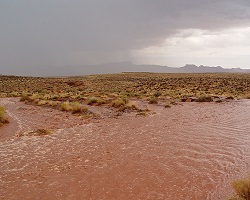show/hide words to know
Water Signs

Arroyos are also called streambeds, wadis, or washes. Image by Stickpen.
The desert may seem like a barren place, with more open areas of soil surface and much less life than some other biomes. So when we look at the desert, we notice more than just the plants and animals. We also notice some peculiar patterns in the ground.
Although deserts are dry for most of the year, when they do get rain, they can get a lot. This creates all kinds of shapes and paths in the sandy desert floor. The runoff from rain creates deep, broad streambeds, called arroyos or wadis that remain dry for most of the year.
The Flash Flood
Sometimes, when a lot of rain falls in the desert, the streambeds aren’t deep enough to hold all the water. The water can overflow, rushing across the hard-packed desert floor in a fast moving flash flood. These floods can cover a large section of ground, moving gravel, clay, sand, and other soil particles out of the streams and spreading them out across a broad, flat area. This broad area is called an alluvial fan. Several alluvial fans can cover a larger area, creating a bajada.
Beneath the Dirt
Though water can rush across the sand in deserts, it can also soak in very quickly in some areas. However, sometimes there are unseen barriers to water below the surface. Hard patches of concrete-like material can develop inches or feet below the desert floor.
This material, called caliche or hardpan, is created when minerals like carbon dioxide and water interact and accumulate over time after drying out.
What is a Haboob?
Water isn’t the only driving force that moves dust or creates barriers in the desert. Huge dust storms, called haboobs, can grow to thousands of feet tall, moving soil and minerals miles across the desert. Over enough time, haboobs can even move enough dirt to create sand dunes in some areas.
Additional images via Wikimedia Commons. Sand dunes by user Brocken Inaglory. Racetrack Playa image by Jason Hickey.
View Citation

Be Part of
Ask A Biologist
By volunteering, or simply sending us feedback on the site. Scientists, teachers, writers, illustrators, and translators are all important to the program. If you are interested in helping with the website we have a Volunteers page to get the process started.










